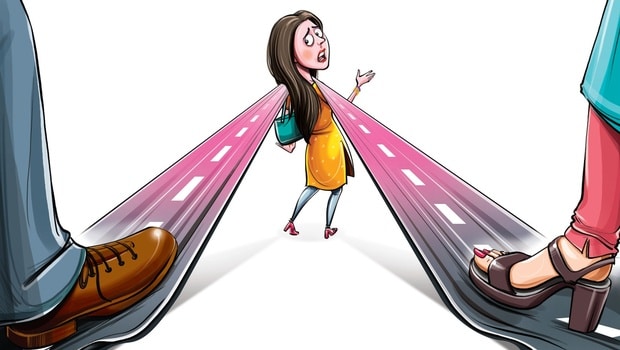
The word ‘harassment’ immediately invokes a graphic image of assault or violence. But as those who have faced harassment on the street assert, it is multi-layered, could take several forms. Street Harassment refers to the harassment of a person not just on the street but also in all public spaces outside of one’s home and workplace.
Stopstreetharassment.org states, “Street harassment includes unwanted whistling, leering, sexist, homophobic or transphobic slurs, persistent requests for someone’s name, number or destination after they’ve said no, sexual names, comments and demands, following, flashing, public masturbation, groping, sexual assault, and rape.”
What is harassment?
Increasingly, harassment is defined from the point of view of the individual at the receiving end; the perpetrator’s intentions are less relevant (Prajnya 2010, Gender Violence in India). For example, Vikram Sundarrman, a non-binary, trans person, says, “Any stigma, discrimination, and violence targeted at a person for their basic identity is harassment. It is an intrusion of privacy in public spaces; questioning a person’s right to be present at that place, especially targeting those who are deviants or non-conforming of socio-cultural stereotypes.”
To Lavanya, writer, harassment is intentionally causing discomfort to a person or group of people in a physical, emotional, verbal, or sexual manner. “Any intrusion of my space by a stranger is harassment. When a random man passes comments at you on the street, when a woman stares at you constantly on the metro, probably for the way you look, when you get hollered at…they’re all forms of harassment,” says Michelle, a volunteer with Hollaback.
Women are more likely to experience street harassment, but non-conformity can be the basis of it. “As a gender-fluid person, I am different in how I dress and how I live. Some people are curious and ask politely, and I’m happy to explain to them. But it is harassment when I am interrogated and made fun of,” notes Vikram.
There’s more acceptance of transgender people today, but the overall mentality is still old-fashioned where they’re also made fun of. “People point, stare and look, giggle and comment when we pass by. However, it is police harassment that is worse for trans sex workers on the streets. Lower rung officials go out of their way to bully us. Then, if they can’t have their way with us, policemen turn on our solicitors, often taking money from them,” narrates Inba, a trans person and founder of Snegithan and Snegithi Trust.
Harassment by women
Malini, a worker at an appalam making unit, is constantly harassed for her outfits. “I get catcalled ‘Mokka Piece’ and ‘Kumki’ because I’m fat. It happens in buses and at the market, all the time. Unlike most of my co-workers, I like modern clothes. But, I feel society doesn’t allow me to express myself, especially when women target me. Don’t I have the freedom to wear what I want?” she avers.
Michelle is plus-sized and is constantly fat-shamed. Narrating her experiences, she says, “Women usually stare long enough to make me uncomfortable. For example, I was recently at a mall eating by myself, and three women next to my table were commenting and laughing at me. I looked back or rather stared back to see what was so funny about me. This is harassment too.”
Forms of harassment
As much as gender-based harassment is statistically high, people can also be harassed because of factors like class, caste, religion, HIV status, body size, disability, nationality, and race. In addition, some people are harassed for multiple reasons within a single harassment incident.
Culturally, marital status, or rather a lack of, can be the basis of harassment too. Manjula, 52, is a fire-accident survivor, and a widow was harassed several times at the temple for both reasons. “I stopped venturing out after a point. I moved to the city with my daughter a few years ago but have never let go of those experiences. So I hardly leave the house.”
Rama, who works as a beautician, has a different narrative altogether. “After my marriage, I have noticed one thing – I don’t get harassed when I wear the kumkum on my forehead or when my mangalsutra or my toe rings are showing. However, on days when I’m wearing a t-shirt and shoes, i.e. hiding the indicators of my marital status, the catcalls come flying, even when I’m sitting behind my husband on the bike. Does this mean I won’t be harassed if I belong to someone?” she demands.
Responding to street harassment can be tricky, especially to Aishwarya, a rape survivor. “There have been times I have been able to respond, but most times, I am stunned into silence. I have carried a pepper spray for many years now and have never used it, though it would have been justified in many cases. Such incidents make me feel lightheaded, and I only want to lock myself in a bathroom and cry. I tend to take a lot of baths after such incidents.”
Since harassment is always about power and control, it is rooted in various kinds of societal discrimination. It’s a rights’ issue because it restricts the victim’s mobility and denies them the ability to feel safe and be treated equally in public spaces. There’s hope every time an experience of harassment is shared and reported. There is power when narratives and people get together to challenge harassment in all its forms. And with both, we are ready to win this fight.
(Archana Seker is a Chennai-based rights activist and writer who is passionate about the creative arts and concerned about the world in general)
Know the Law
There is no specific law related to either sexual harassment or street sexual harassment.
Section 509 of the Indian Penal Code criminalises any word, sound, or gesture intended “to insult the modesty of a woman” or intrude upon her privacy. The punishment is simple imprisonment up to one year, a fine, or both.
Section 354 further extends the provisions of 509 to include assault or the use of ‘criminal force’, with the intention of ‘outraging a woman’s modesty. It also addresses stalking, with imprisonment up to three years for a first conviction, and up to five years for repeat offences, in addition to paying a fine. However, a case will be dismissed if the accused can prove that ‘in the particular circumstances such conduct was reasonable and justified, thereby providing a potential loophole for perpetrators.
Section 294 prohibits obscene acts and the singing or reciting of obscene songs or words in any public place. The punishment is imprisonment up to three months, a fine or both.
State Legislation
Tamil Nadu is the only State with legislation targeting street harassment explicitly. The Prohibition of Harassment of Women Act was passed in 1998 in response to the death of college student Sarika Shah, who died of injuries from street sexual harassment. The amended Act in 2002 provides for up to three years’ jail and a fine of not less than `10,000. The onus of proving innocence lies on those accused. It also provides compensation for victims of street harassment.
(Source: https://goo.gl/LoMTQ1)
Fighting it at Home
- Blank Noise Project (Action heroes to eradicate gender-based violence)
- Safecity (A platform that crowd-sources personal stories of sexual harassment and abuse in public spaces)
- Safety (Equipping women to protect themselves against violence)
- Why Loiter? (People imagining a radically altered city)
- SafetiPin (A social enterprise providing several tech solutions to make our cities safer for women and others)
- Prajnya (Tackles issues related to peace, justice and security, based in Chennai)
Source: newindianexpress.com
Do visit our website to see the various products available @ www. xboom.in




